

Using ‘complexity thinking’ to manage an increasingly complex world – by Paul Cairney, Robert Geyer and Nicola Mathie. Complex policy-making systems are ‘greater than the sum of their parts’.

To understand them we must examine not only the individuals involved but also the ways in which they interact with each other, to share information and combine to produce ‘systemic behaviour’. Professor Paul Cairney, Professor Robert Geyer and Nicola Mathie consider what is involved in using ‘complexity thinking’ to inform policy decisions. In complex systems, policy outcomes often seem to ‘emerge’ despite government attempts to control them, largely because we live in an interconnected world, where ideas, commodities, cultures, and people travel and spread through time and space. Problems and issues such as climate change, violent crime, global financial crisis and health pandemics do not remain confined and static but mutate to effect different spaces, actors, and resources.
‘Complexity thinking’ describes a way to understand these systems, act accordingly, and invite others to do the same. Like this: Perspectives on Cynefin. Over the years I have increasingly used a picture of Cynefin which includes three dynamic movements rather than just present the basic framework.
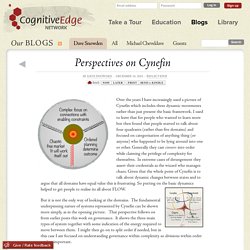
I used to leave that for people who wanted to learn more but then found that people started to talk about four quadrants (rather than five domains) and focused on categorisation of anything thing (or anyone) who happened to be lying around into one or other. Generally they cast sinners into order while claiming the privilege of complexity for themselves. In extreme cases of derangement they assert their credentials as the wizard who manages chaos. Complexity refers to the extent to which an individual or organization differentiates and integrates an event.
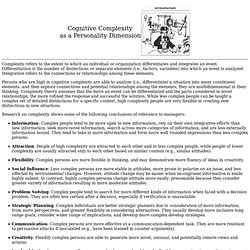
Differentiation is the number of distinctions or separate elements (i.e., factors, variables) into which an event is analyzed. Integration refers to the connections or relationships among these elements. Persons who are high in cognitive complexity are able to analyze (i.e., differentiate) a situation into many constituent elements, and then explore connections and potential relationships among the elements; they are multidimensional in their thinking. Complexity theory assumes that the more an event can be differentiated and the parts considered in novel relationships, the more refined the response and successful the solution.
While less complex people can be taught a complex set of detailed distinctions for a specific context, high complexity people are very flexible in creating new distinctions in new situations. Streufert, S., & Swezey, R. Symonette MakeAssessmentWork ALeadersFramework. Complex system. This article largely discusses complex systems as a subject of mathematics and the attempts to emulate physical complex systems with emergent properties.
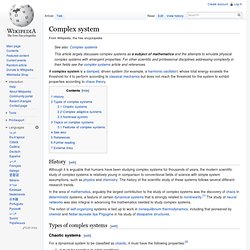
For other scientific and professional disciplines addressing complexity in their fields see the complex systems article and references. A complex system is a damped, driven system (for example, a harmonic oscillator) whose total energy exceeds the threshold for it to perform according to classical mechanics but does not reach the threshold for the system to exhibit properties according to chaos theory. History[edit] Although it is arguable that humans have been studying complex systems for thousands of years, the modern scientific study of complex systems is relatively young in comparison to conventional fields of science with simple system assumptions, such as physics and chemistry.
Complexity. The way we want to make sense of the world around us has often to do with causality.

The question we ask is what caused “it” to happen? The mainstream approach is that an arrow, or arrows, can be drawn. There is a variable, the “it”, that happened, that is now to be explained. In scientific study this variable is regarded as dependent. An independent variable, or variables, that cause it are then sought. But there is something significant happening today. Cybernetics recognized that causality could be circular: A causes B, which causes A. Views of a Dark World. Communicating Complexity. Complex things are hard to communicate.

But it’s nevertheless important to do it. Here are some of my reflections on how to communicate futures thinking or foresight – the rather complex field I’m working in. You might find some advice on how to communicate the complexities of your field. The post appeared first at the APF Emerging Fellows website. Communicating Foresight. » Key insights from Singapore Foresight Week 2013 Roger Dennis : Serendipity Architect. In 2011 the Prime Ministers office in Singapore sponsored a week of foresight conversations.
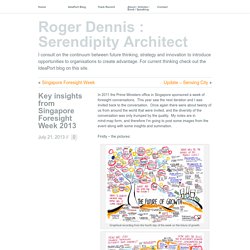
This year saw the next iteration and I was invited back to the conversation. Once again there were about twenty of us from around the world that were invited, and the diversity of the conversation was only trumped by the quality. My notes are in mind-map form, and therefore I’m going to post some images from the event along with some insights and summation. Autopoiesis. 3D representation of a living cell during the process of mitosis, example of an autopoietic system.
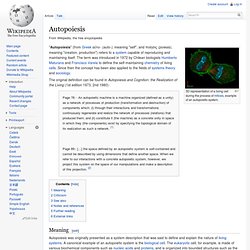
The original definition can be found in Autopoiesis and Cognition: the Realization of the Living (1st edition 1973, 2nd 1980): Page 78: - An autopoietic machine is a machine organized (defined as a unity) as a network of processes of production (transformation and destruction) of components which: (i) through their interactions and transformations continuously regenerate and realize the network of processes (relations) that produced them; and (ii) constitute it (the machine) as a concrete unity in space in which they (the components) exist by specifying the topological domain of its realization as such a network. [1] Page 89:- [...] the space defined by an autopoietic system is self-contained and cannot be described by using dimensions that define another space. Meaning[edit] Criticism[edit] See also[edit] Notes and references[edit] Further reading[edit] External links[edit]